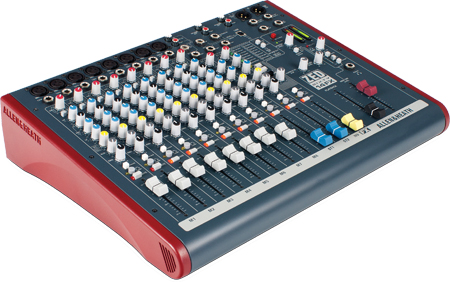ZED60-14FX Mixer Review
The ZED series goes from strength to strength with the new ZED60 range. Liam O’Mullane gets into the studio for a session.

In The Mix
The desk comes with a power lead, manual and the AmpliTube 3 Free software package for guitar processing. This includes 50 ‘gear credits’ to augment the small but quality range of stompboxes, amps, cabinets, microphones and rack effects that are already included. The desk is equipped with two instrument inputs and USB that enable it to be used as a two-track audio interface. AmpliTube is therefore very usable in this respect, and although it’s a USB 1.1 device we managed to get a solid latency of 128 samples while tracking. Strangely, a USB lead is not included.
The desk has eight balanced XLR, two instrument and six line inputs. The inputs are a case of XLR or jack, but there are also two stereo inputs as well, so a potential count of 12 sources can be wired in and mixed. From a live point of view that’s plenty for a band with moderate drum-mic’ing needs. The instrument inputs are claimed to have tube-like behaviour, and while testing with some rock guitar we got everything from nice soft clipping through to much heavier clipping. As expected, all inputs are clear with low noise.
Record And Capture
The two-track USB element of the desk offers two-track stereo in from your computer, which can be fed into the mix via a playback fader as well as the headphone mix and auxiliary buss independently. Setting up to track to a click from your computer or a backing track is therefore quite flexible. The separate monitor outputs are RCA connections which can receive the main mix or a copy of the current headphone output choice.
The feed running from the desk to USB for recording in your software is the same as the two RCA record output connections. This can be set to output the main mix, record buss, aux and FX. The record buss is post-fader, letting you capture a single track upwards. The aux is pre-fader, so there are various ways you can configure things, it just takes a little thinking about at first.
In our tests we used the desk in a studio environment, so tracked one instrument at a time, using the aux for headphone foldback and the faders at zero for capture through the record buss. This proved to be perfectly adequate for our needs. One issue is the lack of higher sample rates and bit-depth, as the desk runs only up to 48kHz at 16-bit.
Onboard Effects
It’s great to have onboard effects in any situation, whether its broadcast, live or studio recording. This desk takes a ‘get what you’re given’ approach as they don’t have any user parameters. For recording vocals we tried many of the plate, hall and larger ambience effects. These sounded good but we couldn’t find anything with medium to small room decay times, which makes them more suited to live use. We wanted to track a tight, intimate vocal and had to settle for a plate at a very quiet setting as a compromise to hide the decay as much as possible. The delays and modulation effects are also good-quality, but again, just a little limited in terms of application.
Overall, the desk has plenty of features that make it suitable for a variety of applications. The sound quality throughout all inputs and outputs is very good and there’s little crosstalk to be heard. We feel this desk is a good choice if you need the option to go and record some small gigs, track bands and then have a studio hub at home, as long as the USB limitations aren’t an issue for you.
Verdict
+ Clean sound throughout
+ Lots of routing options
+ Two instrument inputs
+ Onboard FX
– Takes a while to fully understand the routing
– USB 1.1
– 16-bit only
– No USB lead included
– Limited application for FX
Another desk that holds up to Allen & Heath’s reputation for sound quality and build, but it’s slightly limited in terms of FX and the fact that it’s USB 1.1-only. We’d like to see USB 2.0 in future models.
8/10
This overview looks at the ZED60 14Fx and the 10Fx:


